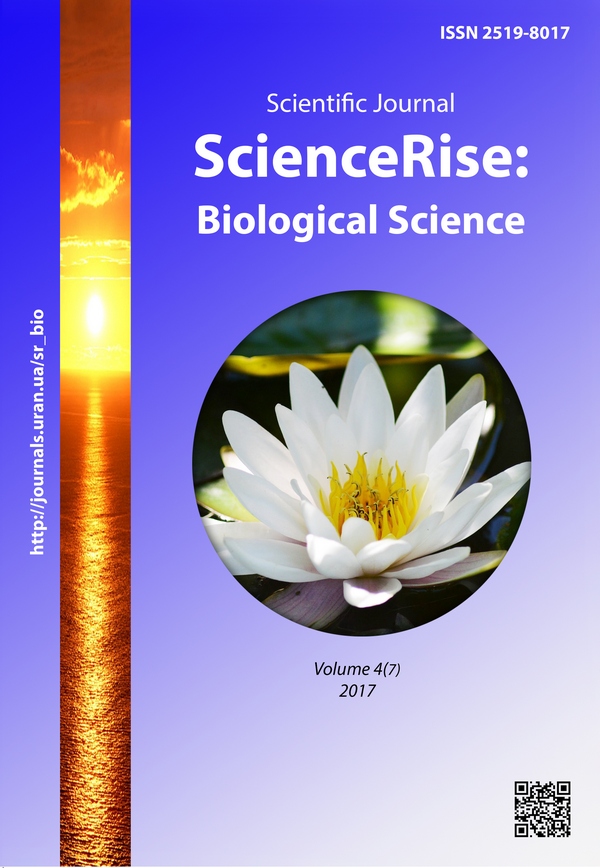Характеристика питания кефалевых рыб в шаболатском лимане
DOI:
https://doi.org/10.15587/2519-8025.2017.109290Ключові слова:
Шаболатский лиман, Украина, кефали лобан, остронос, сингиль, пиленгас, состав пищи, индексы пищевого сходстваАнотація
Впервые исследован качественный состав пищи, рассчитаны индексы пищевого сходства для кефалевых рыб (лобана, остроноса, сингиля и пиленгаса) разного возраста в условиях Шаболатского лимана северо-западной части Черного моря в разные сезоны года. Установлено, что при сходном характере питания кефали остронос и сингиль предпочитают животную пищу, а лобан и пиленгас – детрит и растительную пищу. Учитывая характер питания кефалевых и сокращение запасов зоопланктона и зообентоса в лимане в настоящее время, на основании проведенных исследований рекомендуется как основный объект пастбищной марикультуры использовать лобана и пиленгаса основу питания, которых составляет детрит и растительная пища
Посилання
- Shekk, P. V. (2012). Biologicheski-tehnologicheskie osnovyi kultivirovaniya kefalevyih i kambalovyih ryib [Biological and technological bases of mullet and flounder fish cultivation]. Kherson: PC Grin, 305.
- Shekk, P. V., Kulikova, N. I. (2005). Marikultura ryib i perspektivyi eyo razvitiya v chernomorskom baseyne [Mariculture of fish and its development prospects in the Black Sea basin]. Kyiv, 306.
- Starushenko, D. I., Shekk, P. V., Kulikova, N. I. (1997). Protsess akklimatizatsii dalnevostochnoy kefali pilengasa Mugil so-iuy Bas. v zapadnoy chasti Chernogo morya [The process of acclimatization of the Far Eastern mantle pilengas Mugil so-iuy Bas. in the western part of the Black Sea]. Akvakultura: problemy i dostizheniya, 4/5, 1–22.
- Dimitriev, Ya. I. (1979). Ispolzovanie lagun Chernogo morya v ryibohozyaystvennyih tselyah [Use of the Black Sea lagoons for fishery purposes]. Kishinev: Shtiintsa, 174.
- Burnashev, M. S., Chepurnov, V. S., Dmitriev, Ya. I. (1966). Shabolatskiy liman kak nagulnaya baza dlya molodi kefali [Shabolatsky estuary as a feeding ground for young mullets]. Scientific notes of the Kishinev State University, 23 (2), 39–69.
- Duka, L. A. (1973). Pitanie i pischevyie vzaimootnosheniya lichinok i molodi rib nekotorih ekologicheskih gruppirovok v biotsenoze tsistoziryi [Nutrition and nutritional relationships of fish larvae and juveniles of some ecological groupings in the cystoseira biocenosis]. Biology of the sea, 31, 46–70.
- Kirilyuk, M. M., Shekk, P. V. (1976). Izuchenie pitaniya ryib Chernogo morya. Biologo-fiziologicheskie osnovyi pitaniya morskih ryib na raznyih stadiyah razvitiya (kambalovyie, kefalevyie, byichkovyie) [Studying the nutrition of the Black Sea fishes. Biological and physiological bases of sea fishes feeding at different stages of development (flounder, cephalic, bovine)]. Report on the implementation of research work No. 0173.7142571. Southern Scientific Research Institute of Fisheries and Oceanography. Odessa, 59.
- Chechun, T. Ya. (2002). Pitanie pilengasa v Kerchenskom prolive i Azovskom more [Feeding of the Pilengas in the KerchStrait and the AzovSea]. Hydrobiological journal, 38 (3), 45–51.
- Pryahin, Yu. V., Shnitskiy, V. A. (2006). Metodyi ryibohozyaystvennyih issledovaniy [Methods of fishery research]. Krasnodar: Kuban State University, 214.
- Pravdin, I. F. (1966). Rukovodstvo po izucheniyu rib [Guide to the study of fish]. Moscow: Pischevaya promyishlennost, 376.
- Metodicheskoe posobie po izucheniyu pitaniya i pischevyih otnosheniy ryib v estestvennyih usloviyah [Methodical manual on the study of nutrition and food relations of fish in the wild] (1974). Moscow: Science, 250.
- Shekk, P. V., Kryukova, M. I. (2010). Otsenka kormovoy bazyi i perspektivyi ispolzovaniya Shabolatskogo limana dlya pastbischnoy marikulturyi [Estimation of fodder base and prospects of using Shabolatsky estuary for pasture mariculture]. Visnyk of Zaporizhzhya National University, 1, 1126–1135.
##submission.downloads##
Опубліковано
Як цитувати
Номер
Розділ
Ліцензія
Авторське право (c) 2017 Pavel Shekk, Marina Burgaz

Ця робота ліцензується відповідно до Creative Commons Attribution 4.0 International License.
Наше видання використовує положення про авторські права Creative Commons CC BY для журналів відкритого доступу.
Автори, які публікуються у цьому журналі, погоджуються з наступними умовами:
1. Автори залишають за собою право на авторство своєї роботи та передають журналу право першої публікації цієї роботи на умовах ліцензії Creative Commons CC BY, котра дозволяє іншим особам вільно розповсюджувати опубліковану роботу з обов'язковим посиланням на авторів оригінальної роботи та першу публікацію роботи у цьому журналі.
2. Автори мають право укладати самостійні додаткові угоди щодо неексклюзивного розповсюдження роботи у тому вигляді, в якому вона була опублікована цим журналом (наприклад, розміщувати роботу в електронному сховищі установи або публікувати у складі монографії), за умови збереження посилання на першу публікацію роботи у цьому журналі.










